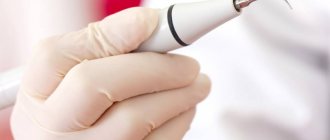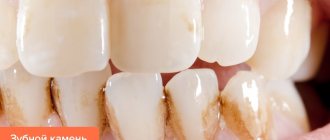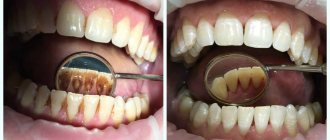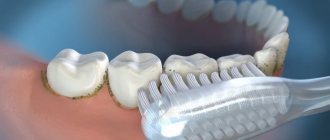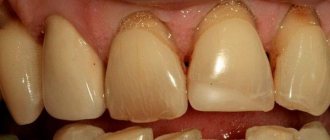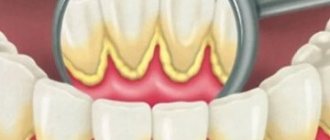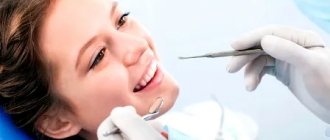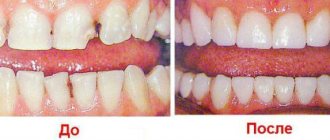Chief editor of the site:
Snitkovsky Arkady Alexandrovich
Chief physician of the professorial dentistry “22 Century”, dentist, orthopedic dentist
Author of the article:
Scientific team of dentistry “22 Century”
Dentists, candidates and doctors of medical sciences, professors
Removal of dental complications is a dental service that is currently very popular
Dental plaque is a general term for dental plaque and tartar . They are one of the most common causes of dental and gum disease. The consequences of dental plaque are gingivitis, periodontitis, caries.
Removing dental complications is a dental service that is currently very popular . Today, there are different methods for removing plaque and tartar.
Types of Tartar
Tartar has its own classification - according to the field of education. Based on this feature, mineralized deposits are divided into two types:
- Subgingival calculus. Deposits accumulate under the edge of the gums, in the area of the gum pockets. A characteristic feature of subgingival tartar is its increased hardness. Mineralized subgingival deposits can cause an active inflammatory process in the periodontium (soft tissues of the oral cavity) and lead to gingivitis or periodontitis. It is impossible to remove subgingival stone at home: only a dentist can remove deposits in this area;
- Supragingival tartar forms above the gum level and is therefore clearly visible on the teeth. It can become stained from contact with food, and in smokers it has a distinct yellow or brown color. Supragingival tartar harms the healthy state of enamel, increases the risk of caries and, of course, spoils the appearance of teeth. It needs to be removed urgently, because the longer the stone is on the teeth, the denser and harder it becomes.
Symptoms such as the appearance of bad breath, discoloration of the gums, heavy plaque on the teeth after eating, and roughness of the teeth may tell you that tartar has formed on your teeth. If you observe such signs in yourself, be sure to contact the dentist for tartar removal and professional oral hygiene!
Caring for your teeth after ultrasonic cleaning
After the procedure, especially if a lot of plaque has been removed, there is a slightly increased sensitivity of the teeth to temperature and chemical irritants, so for 24 hours after cleaning, patients are advised to refrain from eating excessively hot, cold, sour and salty foods. It is advisable to follow a “white diet” for a couple of days, as after teeth whitening, to exclude strongly coloring foods from the diet (red wine, coffee, black tea, beets, some bright fruits and juices from them) so that the cleaned enamel does not absorb food dyes, and on the contrary, enrich it with solid and fiber-containing products that will prevent the appearance of plaque and stones (fruits, vegetables, nuts, etc.).
If sensitivity is severe, it is recommended to replace your regular toothbrush with a soft-bristled brush for several days and purchase toothpaste that reduces sensitivity.
After each meal, you need to rinse your mouth with clean water - this rule must be observed not only after ultrasonic cleaning, but also constantly.
On the first day or two, it is also recommended to brush your teeth after every meal.
Methods for removing tartar used in dentistry
Previously, only mechanical cleaning was used to remove tartar in dentistry, which involved the use of special hand tools: scalers, curettes, excavators, smoothers, chisels, rasps. The procedure was labor-intensive, long and painful for the patient, and also very traumatic.
When manually removing tartar, a fairly large layer of healthy tissue was removed from the teeth and this led to unpleasant sensitivity of the teeth and thinning of the tooth enamel. Nowadays, mechanical removal of tartar is used extremely rarely, only in cases where the patient has contraindications to other methods of cleaning teeth from deposits.
Another outdated and rarely used method of removing plaque is to clean teeth from plaque using special chemical solutions.
The teeth were treated with preparations based on alkalis or acids that dissolve mineralized deposits. However, the chemical method of removing tartar is aggressive, it carries a high risk of burns to the soft tissue of the oral cavity, it negatively affects the condition of tooth enamel, so dentists have long abandoned its use. Nowadays, two modern and highly effective methods are used to remove tartar - ultrasonic cleaning and laser cleaning. We will tell you about these technologies in detail below.
Curettage – mechanical removal of dental plaque
Curettage is a procedure during which the dentist removes dental plaque mechanically . This is necessary when plaque or stones are in a periodontal pocket that is inaccessible to ultrasound and an aerosol jet.
There are two types of curettage:
- Closed;
- Open – involves an incision in the gum.
During curettage, not only deposits on tooth enamel are removed, but also pathologically altered tissues .
Ultrasound removal of tartar
Ultrasonic tartar removal is a technology that allows you to quickly and painlessly remove mineralized plaque without damaging tooth enamel. The procedure will use a special ultrasonic device with a tip - a scaler. The generator in the device creates ultrasonic waves, which are transmitted to the scaler. The frequency of the waves can be adjusted, which gives the dentist the opportunity to choose the most effective and safe mode of operation.
When removing tartar with ultrasound, different types of tips can be used. By changing the tips, the dentist will clean the outer part of the teeth from mineralized deposits and remove plaque in the subgingival area. Effective and rapid removal of tartar is due to a double action:
- An ultrasonic wave is applied to the tip with a certain frequency, creating vibrations that destroy tartar mechanically;
- Since ultrasonic cleaning can be carried out using liquid, the simultaneous supply of water and ultrasonic waves leads to the effect of cavitation or, in simple words, the formation of a large number of microbubbles that loosen tartar and improve the process of its separation from tooth enamel.
The scalers of modern ultrasonic devices are equipped with illumination, which improves the quality of tartar removal.
AirFlow dental plaque removal device
After polishing, the doctor applies special protective compounds to the teeth, usually varnish with the addition of fluoride
AirFlow - this is a technology that can be used to remove plaque and make teeth half a tone lighter . To do this, tooth enamel is treated with a jet consisting of a liquid, an aerosol and an abrasive substance, the basis of which is sodium bicarbonate (soda). This technique is quite effective and soft, gentle on dental tissues.
Benefits of ultrasonic tartar removal
Ultrasonic tartar removal technology has the following advantages:
- It is highly effective; using ultrasound, it is possible to remove tartar from both the external surfaces of the teeth and the subgingival space;
- When removing tartar, ultrasound does not injure or damage tooth enamel;
- Ultrasound destroys pathogenic microflora in the oral cavity, and therefore removal of stone and plaque by ultrasonic cleaning is an excellent prevention of various dental diseases;
- The procedure for removing tartar using ultrasound is quick and painless for the patient.
The advantages of ultrasonic tartar removal include the affordable price of the service. Ultrasonic cleaning is universal and can be carried out as an independent hygienic procedure or in combination with Air Flow cleaning. It is imperative to remove tartar with ultrasound before dental treatment, prosthetics, implantation, or wearing braces.
Is it possible to brush teeth with ultrasound during pregnancy?
The best period for preventive cleaning is the second trimester of pregnancy. At this time, the child is already reliably protected by the placenta and is actively developing. Increased growth of the skeletal system provokes tooth decay in the mother, so we must try to protect ourselves as much as possible.
Ultrasonic cleaning with the addition of Air-Flow is considered by experts to be one of the best methods of prevention, as it allows you to sanitize the oral cavity as effectively as possible. The risk of caries is reduced, which allows you to simply save your teeth.
Before visiting a dentist, you must obtain permission from a gynecologist, since the decision is made individually, based on the woman’s condition.
Important. Ultrasound does not affect mother and child and does not cause allergies. The procedure is painless, and the mother feels excellent after the session.
Laser tartar removal
Laser tartar removal has been used in dentistry relatively recently. This technology involves removing mineralized deposits with a directed laser beam. The procedure is quick, painless and has the following advantages:
- High security. The laser beam destroys only plaque and does not damage the enamel and soft tissues of the oral cavity;
- Laser radiation destroys pathogens and stops inflammatory processes;
- Laser tartar removal takes place without discomfort or pain.
The disadvantages of laser tartar removal include a fairly large list of contraindications and the high cost of the procedure.
Why hard deposits form
The formation of microbial plaque on the teeth occurs constantly, which is why it is so important to systematically brush your teeth - every time after waking up and before going to bed. You can reduce the intensity of plaque formation by rinsing your mouth every time after eating. Among the main factors that provoke the accumulation of plaque and stone, experts identify the following prerequisites:
- insufficient oral care - teeth need to be brushed twice a day, and this is a prerequisite for maintaining the proper level of hygiene. Let's say you forgot to brush your teeth at night. During sleep, saliva will enter into an active reaction with the bacteria present, and they will begin to multiply rapidly, which can lead to the gradual destruction of dental tissues and the development of carious processes,
- incorrect daily brushing technique - even if you brush your teeth properly twice a day, this does not guarantee impeccable cleanliness of the oral cavity. If you use the brush incorrectly, food debris and bacteria will remain in hard-to-reach places. To minimize such accumulations, it is better to consult a dentist about this, find out everything about how to brush your teeth correctly,
- Diet is another important factor that can cause excessive deposits on teeth. Uncontrolled consumption of sweets will ultimately lead to the rapid destruction of hard tissues and the development of caries.
“Ultrasonic cleaning is not that painless. Personally, it was a little unpleasant for me, but quite tolerable. After the session, even the taste in my mouth seemed to change, there was freshness, some kind of lightness. My teeth became many times whiter, but the effect did not last long. I think if a person doesn’t smoke or drink coffee, the result will be more lasting.”
Maxim87, Moscow, from correspondence on the forum www.32top.ru
Those who smoke will definitely not be able to avoid plaque formation. Today, cigarettes contain a large amount of resins, which settle on the enamel and lead to its rapid darkening. Lovers of coffee and caffeinated drinks are also at increased risk.
Smoking leads to the formation of tartar
Air Flow for removing tartar
Air Flow is a technology used for professional teeth cleaning. It copes well with pigmented soft plaque, helps lighten tooth enamel to its natural shade, refreshes and disinfects the oral cavity. But with so many advantages, Air Flow is ineffective in the fight against tartar.
If a large amount of hard dental deposits have accumulated in the patient’s oral cavity, to remove them, properly clean with ultrasound or laser and only then use Air Flow.
Restrictions to the procedure
It is worth noting that the technique under consideration has certain contraindications. Here are the main restrictions on the use of ultrasound:
- pathologies of blood vessels and heart,
- asthma, tuberculosis and other diseases related to the functioning of the lungs and respiratory system,
- infections, including HIV, hepatitis,
- the presence of implants and prosthetic devices in the mouth,
- children's age (up to 16-18 years),
- increased sensitivity of the enamel layer,
- diabetes,
- oncology,
- epilepsy and other disorders of the nervous system,
- reduced immunity, which manifests itself in frequent colds and other diseases.
During pregnancy, ultrasonic cleaning is allowed, but in the first trimester it is better to wait. During this period, the expectant mother’s body is overly sensitive and susceptible to any external influences.
Is it possible to remove tartar at home?
On the Internet you can find countless recipes that claim to help remove tartar. Most of these recipes involve the use of caustic substances that must be applied to the surface of the teeth and, under the influence of these substances, the tartar should dissolve.
But we do not advise you to conduct such experiments on your health. Using caustic solutions will not help you remove tartar, but it will weaken and destroy tooth enamel and can lead to burns of the soft tissues of the mouth and other unpleasant consequences. In addition, no folk remedies will relieve you of subgingival tartar.
You need to remember that tartar removal should be carried out in a dental clinic, by a competent hygienist who uses safe materials and modern tools in his work! There is no need to be afraid of this procedure - it is painless, and in addition, before removing tartar, you can always apply local anesthesia, which completely removes all possible unpleasant sensations.
Estimated cost of the service
The cost of the procedure at different medical centers may vary. How much it will cost to remove deposits with ultrasound depends on various factors, including whether further processing is carried out with an AirFlow device, what model of scaler is used, as well as on the pricing policy of the institution as a whole.
| Name of institution | Cost of the procedure, rub. |
| "Star-Dent" | 4 000 |
| Lanri Clinic | 3 000 |
| "Denta-El" | 4 900 |
| Smile-at-Once | 3 500 |
| "ONMED" | 5 100 |
The table shows approximate prices for the service in question - please check the exact price when contacting us. You need to understand that this is one of the few ways to remove hard deposits, and therefore protect yourself from caries and many other dental problems.
Ultrasonic cleaning has many undeniable advantages, including absolute safety and highest efficiency. Regularly undergoing such a procedure at least twice a year will be the best protection against inflammation and carious processes. In addition, systematic visits to the dentist’s office are required in any case, because for prevention such visits should be made at least twice a year.
Prevention of tartar formation
Is it possible to prevent tartar from forming? This question is often asked to dentists by patients after dental plaque removal procedures. Alas, there are no technologies in dentistry that would help get rid of tartar once and for all, but prevention can be carried out to promote the formation of deposits in smaller quantities and slow down the rate of their formation.
Effective prevention of tartar formation will include the following measures:
1. Regular brushing of teeth with the correct movements and the right toothbrush and toothpaste. If you don’t know which brush and paste are right for you, the dental hygienists of our clinic in Moscow, “Aesthetica”, will help you find the answer to this question!
2. When brushing your teeth, be sure to use dental floss or special brushes to help remove plaque and food debris from the spaces between your teeth.
3. Buy irrigators that help remove plaque from the subgingival space.
4. Stop smoking, drinking alcohol frequently, reduce the amount of sweet foods in your diet, and eat solid foods.
To remove tartar in a timely manner, visit the dentist once every six months and carry out professional oral hygiene procedures.
Contraindications
A significant drawback of the procedure is the presence of contraindications. The doctor will definitely ask if you have any diseases or orthopedic structures, the presence of which implies a refusal to carry out cleaning.
Contraindications in this case include:
- acute bronchitis, asthma;
- diseases of the heart and blood vessels, installed pacemaker;
- infectious diseases, including ARVI;
- first trimester of pregnancy;
- presence of implants, bridges, braces;
- in a separate line – epilepsy, hepatitis, HIV.
It is also not recommended to perform the procedure on children's baby teeth.
Comprehensive teeth cleaning: service from our dentistry in Moscow “Aesthetica”
To ensure high-quality removal of tartar, we offer our patients a comprehensive teeth cleaning service, which includes:
- Ultrasonic cleaning;
- Air Flow cleaning;
- Grinding and polishing of enamel;
- Fluoridation.
An integrated approach to teeth cleaning guarantees a high quality procedure and is an excellent prevention of caries and gum inflammation. After the cleaning procedure, our hygienists will definitely give you recommendations on proper oral hygiene to help keep your teeth beautiful and healthy.
In our clinic, modern equipment is used to carry out comprehensive teeth cleaning, and all conditions have been created for comfortable treatment and procedures. We are proud that we can offer you the best dental technologies, high-quality materials from world-famous manufacturers and, of course, our professionalism, knowledge and experience.
Dental clinic “Aesthetica” - with us your teeth will be healthy and your smile will be dazzling! Come to us: we have opened two branches for you in Moscow - in Barvikha and in Podsosensky Lane!
Actions after the procedure - prevention
To minimize the intensity of dental plaque formation, proper care and prevention should be provided. To do this, experts recommend adhering to the following rules:
- use a brush whose degree of hardness corresponds to the condition of your enamel - it is better to consult a specialist on this matter,
- carry out standard cleaning daily - after waking up and before going to bed,
- You need to brush your teeth in a circular motion for at least 5 minutes,
- after eating, do not forget to floss, rinse your mouth to remove food debris after a meal,
- for better care, it is worth purchasing an irrigator - a portable device supplies a powerful stream of water and air under high pressure,
- do not forget about the back side of the rows, as well as the surface of the tongue, where a huge number of bacteria are concentrated,
- include hard vegetables and fruits in your diet - when biting, the enamel is cleansed of microbial plaque,
- eat less sweets, limit your consumption of sugary drinks, coffee and black tea. You also need to stop smoking.
A good product for caring for the structure is an irrigator.
To maintain hygiene, it is recommended to undergo comprehensive cleaning twice a year. According to experts, this is the optimal frequency that will prevent the formation of too much deposits that can provoke the development of caries and other dental problems.
